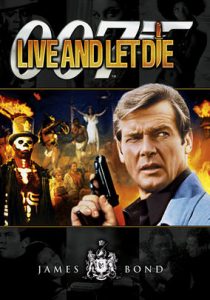Live and Let Die-1973
Director Guy Hamilton
Starring Roger Moore, Jane Seymour
Scott’s Review #646
Reviewed May 25, 2017
Grade: A-
When Live and Let Die was released in 1973, it began a new chapter in the James Bond film franchise with the introduction of a new Bond.
Sean Connery refused to do any more Bond pictures, and Roger Moore was crowned the new film hero and successfully made the role his own during his tenure.
My personal favorite Bond from top to bottom- I enjoyed the wry humor Moore added- he makes Live and Let Die more than it otherwise might have been with a less charismatic actor.
The story and the subsequent elements of the film have issues, but this installment holds a soft spot for me as it was one of my first exposures to the mountainous franchise that is Bond, and I adore the period of the mid-1970s.
Bond (Moore) is summoned to duty by his leader, M after three MI6 agents are simultaneously killed in the Caribbean, New Orleans, and at the United Nations in New York City. Bond is then tasked with figuring out who killed these agents and how the deaths are connected.
The adventure takes Bond from Harlem to an unnamed island in the Caribbean, and back to the bayous of southern Louisiana as he tangles with a heroin drug lord, Dr. Kananda.
Bond’s main love interest in the film is the virginal tarot card reader, Solitaire, played by Jane Seymour.
Live and Let Die is a breakthrough in some ways, though the film admittedly contains both positives and negatives worthy of discussion.
Since the film was made in 1973, following a successful run of “Blaxploitation” films like 1971’s Shaft and 1972’s Super Fly, the film is influenced by those in style (for better or worse).
This means that all of the villains are black, from the main villain, Kananga, to various henchmen and even background criminals growing the massive amounts of heroin shipped to the United States for distribution.
Having such representation among a minority group is fantastic and feels cutting edge, but stereotypes such as derogatory racial epithets, a pimpmobile, and the addition of weird voodoo, exist.
Another major flaw to the film, and despite my overall warmth for Live and Let Die, is the goofiness that the film turns into towards the end of the film.
At a certain point, the film feels like a different film from what it starts as, which becomes quite jarring-the introduction of Sheriff J.W. Pepper during a Louisiana chase scene turns the film into more of a cheesy Dukes of Hazzard episode, with bumbling law enforcement officials, rather than a quality film, and the southern stereotypes run rampant.
Why does a throwaway scene of a speedboat racing through an outdoor wedding feature all high society white folks with nary a black character existing other than as servants?
Some diversity in this scene would have been nice considering the film goes out of its way to feature black characters.
Still, many positives do exist. Live and Let Die has the honor of containing the first-ever black Bond girl- the CIA double agent, Rosie Carver, who sadly meets a grisly ending far too soon.
Gloria Hendry’s chemistry with Roger Moore is readily apparent, though the film chooses to make the character inept rather than a true equal. The smoldering sex scenes between the duo are wonderful and groundbreaking to watch so the film gets major props for pushing the envelope in this way.
Memorable is the terrific title theme song, “Live and Let Die”, by Paul McCartney and Wings. The success of this hit song, especially decades later, does wonders to elevate the film and keep it relevant in pop culture.
Also great to see are the location sequences and good action car chase scenes along the West Side Highway in New York City and into Harlem.
A treat for this retro fan is the inclusion of early 1970s Chevrolet Impalas and Chevy Novas throughout the entire feature film- was Chevy a financial backer?
Classic cars are a major inclusion in Live and Let Die, which as a current-day viewer is a cool treat and quite retro.
In the way of the primary villain and primary Bond girl, the film misses. Jane Seymour is a dud as Solitaire, a character that really should have been played by a black actress. Seymour and Moore have zero chemistry and her character is weak and simpering, lacking any sort of backbone.
Similarly, Yaphet Kotto as Dr. Kananga seems miscast and lacks any real qualities that make him neither devious nor dangerous, and his inevitable swan song underwhelms.
Live and Let Die (1973) is not the greatest in the Bond collection and suffers from some problematic, now-dated aspects, racial issues, and a silly overtone, but, perhaps more so as a terrific childhood memory, I hold a particular fondness toward this film despite many negatives.
Oscar Nominations: Best Song-“Live and Let Die”
